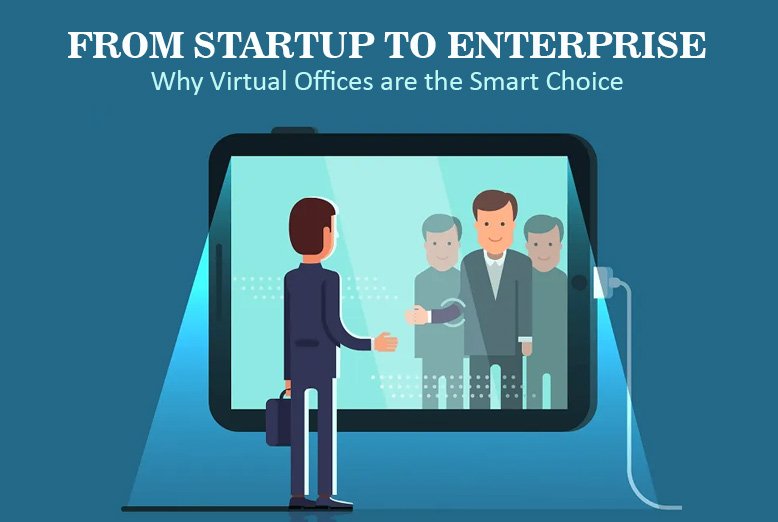In today’s fast-paced business world, companies are always looking for ways to stay competitive. One smart solution many businesses are turning to is the virtual office. Virtual offices offer flexibility, cost savings, and a professional image, making them an excellent choice for companies of all sizes, from startups to large enterprises.
What is a Virtual Office?
A virtual office provides businesses with many of the benefits of a traditional office without the need for physical space. Services typically include a professional business address, mail handling, phone answering services, and access to meeting rooms. Employees can work from anywhere, connecting through the internet.
Benefits for Startups
1. Cost Savings
Startups often have limited budgets, and renting a physical office space can be expensive. Virtual offices eliminate the need for rent, utilities, and office maintenance costs. This allows startups to invest more in other critical areas such as marketing, product development, and hiring key personnel.
2. Professional Image
A virtual office provides a prestigious business address, which can enhance the company’s professional image. This is particularly important for startups trying to establish credibility with clients and investors. A reputable address can make a small business look more established and trustworthy.
3. Flexibility
Startups often need to adapt quickly to changing market conditions. A virtual office allows for flexibility in scaling up or down without the constraints of a long-term lease. This means startups can easily add or remove services as needed, making it easier to respond to growth or cutbacks. Exploring the right virtual office setup can significantly enhance this adaptability, offering startups tailored solutions that meet their dynamic business requirements.
4. Access to Talent
With a virtual office, startups are not limited by geography when hiring. They can attract talent from anywhere in the world, ensuring they have the best people working for them. This can be a significant advantage in the competitive startup environment.
Advantages for Growing Businesses
1. Scalability
As businesses grow, their needs change. Virtual offices offer scalable solutions that can grow with the company. This means adding more virtual office services or even transitioning to a hybrid model with some physical office space if needed.
2. Reduced Overheads
Growing businesses often face increasing overhead costs. A virtual office helps reduce these expenses by cutting down on rent, utilities, and office supplies. The savings can then be redirected to other important areas such as expanding the product line or entering new markets.
3. Improved Work-Life Balance
A virtual office allows employees to work from home or any location of their choice. This flexibility can lead to improved work-life balance, higher job satisfaction, and increased productivity. Happy employees are often more engaged and committed to their work, which can drive business growth.
4. Access to Global Markets
With a virtual office, businesses can easily establish a presence in multiple locations without the need for physical offices. This allows for easy entry into new markets and the ability to serve a global customer base. Companies can test new markets without significant financial commitments.
Benefits for Established Enterprises
1. Cost Efficiency
Even large enterprises can benefit from the cost savings associated with virtual offices. By reducing the need for extensive office space, companies can save on rent and maintenance. These savings can then be used to invest in technology, research and development, or other strategic initiatives.
2. Business Continuity
Virtual offices provide a level of business continuity that traditional offices cannot match. In the event of a disaster or unforeseen event, employees can continue to work from any location with internet access. This ensures that the business can keep running smoothly without interruptions.
3. Environmental Impact
Many large enterprises are focusing on sustainability. Virtual offices contribute to reducing the company’s carbon footprint by minimizing commuting and the need for large office spaces. This aligns with corporate social responsibility goals and can enhance the company’s reputation.
4. Enhanced Collaboration
Virtual offices are equipped with modern communication tools such as video conferencing, instant messaging, and collaborative software. These tools enable seamless communication and collaboration among team members, regardless of their location. This can lead to more innovative solutions and faster decision-making.
Challenges and Solutions
While virtual offices offer numerous benefits, they also come with challenges. Here are some common issues and how to address them:
1. Communication Issues
Without face-to-face interactions, miscommunication can occur. To overcome this, businesses should invest in robust communication tools and establish clear communication protocols. Regular virtual meetings and updates can help keep everyone on the same page.
2. Maintaining Company Culture
Building and maintaining a strong company culture can be difficult in a virtual environment. Companies can address this by organizing virtual team-building activities, regular check-ins, and creating online spaces for social interactions. It’s important to make employees feel connected and valued.
3. Managing Remote Teams
Managing a remote team requires different skills than managing an in-office team. Training managers on remote management techniques and using project management tools can help keep teams organized and productive. Setting clear expectations and goals is also crucial.
4. Data Security
With employees accessing company data from various locations, ensuring data security is vital. Companies should implement strong cybersecurity measures, such as VPNs, encryption, and regular security training for employees. It’s essential to protect sensitive information from potential threats.
Implementing a Virtual Office
Transitioning to a virtual office requires careful planning. Here are steps to successfully implement a virtual office:
1. Assess Needs
Determine which virtual office services are necessary for your business. This could include a business address, mail handling, phone services, and access to meeting rooms. Understanding your needs will help you choose the right virtual office provider.
2. Choose a Provider
Research and select a reputable virtual office provider that offers the services you need. Look for providers with positive reviews, reliable customer service, and flexible plans that can grow with your business.
3. Set Up Technology
Ensure you have the right technology in place for seamless communication and collaboration. This includes reliable internet access, video conferencing tools, project management software, and secure data storage solutions.
4. Establish Policies
Create clear policies and guidelines for remote work. This should cover communication protocols, work hours, data security, and performance expectations. Clear policies help ensure everyone is on the same page and can work efficiently.
5. Train Employees
Provide training for employees on how to use virtual office tools and adhere to company policies. Offer ongoing support to help them adjust to the new way of working. Training helps employees feel confident and capable in a virtual environment.
6. Monitor and Adjust
Regularly monitor the effectiveness of your virtual office setup. Gather feedback from employees and make necessary adjustments to improve the experience. Staying adaptable is key to long-term success.
Future of Virtual Offices
The trend towards virtual offices is likely to continue as technology advances and businesses seek more flexible solutions. Here are some trends to watch for:
1. Increased Adoption
More businesses, including those traditionally resistant to remote work, are likely to adopt virtual offices. The benefits of cost savings, flexibility, and access to a global talent pool are too significant to ignore.
2. Advancements in Technology
Continued advancements in communication and collaboration tools will make virtual offices even more effective. Virtual reality (VR) and augmented reality (AR) could revolutionize virtual meetings, making them more immersive and interactive.
3. Hybrid Models
Many businesses may adopt a hybrid model, combining virtual offices with physical spaces. This allows for the best of both worlds, providing flexibility while still maintaining a physical presence when needed.
4. Focus on Employee Well-being
As remote work becomes more common, businesses will place a greater emphasis on employee well-being. This includes mental health support, ergonomic home office setups, and promoting work-life balance.
Conclusion
From startups to large enterprises, virtual offices offer a smart solution for modern business challenges. They provide cost savings, flexibility, and access to a global talent pool, while also enhancing business continuity and sustainability. By addressing potential challenges and implementing best practices, businesses can successfully transition to a virtual office and reap the numerous benefits it offers. The future of work is here, and virtual offices are at the forefront of this exciting evolution.
Also Read: What is a Virtual Office, and Should You Be Using One?















